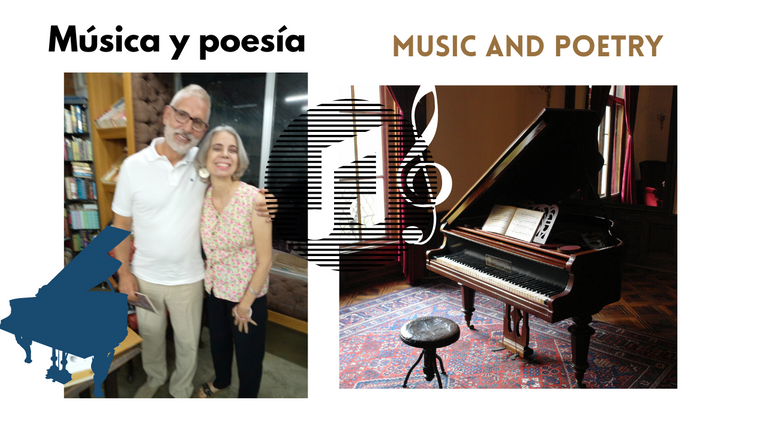
Banner diseñado en canva.com La foto con el poeta Fermín Higuera fue tomada con la cámara de mi teléfono móvil Infinix HOT 10
Fuente de la imagen del piano Fuente
Banner designed in canva.com The photo with the poet Fermín Higuera was taken with the camera of my Infinix HOT 10 cell phone.
Source of the piano image Source
Somos energía, el universo es energía y todo lo vivo que hay en él es energía. Sobre este interesante tema escuché conversar a dos poetas y pianistas, Edgar Vidaurre, actual presidente del Círculo de Escritores de Venezuela y Fermín Higuera (Santa Cruz de Tenerife, 1961), en la librería Kalathos de Caracas, este viernes 23 de junio de 2023. Se conocieron esa tarde, pero se estableció entre ellos una maravillosa sincronicidad de la que tuve el privilegio de ser testigo. Hablaban de música y de la interpretación musical, pero terminaron conversando sobre la música y la energía cuántica. La poeta Carmen Cristina Wolf y la actriz y poeta Yoyiana Ahumada también acompañaron al poeta canario en el evento.

Fotos tomadas con la camera de mi teléfono móvil Infinix HOT 10
La poeta Carmen Cristina Wolf dando la bienvenida al evento
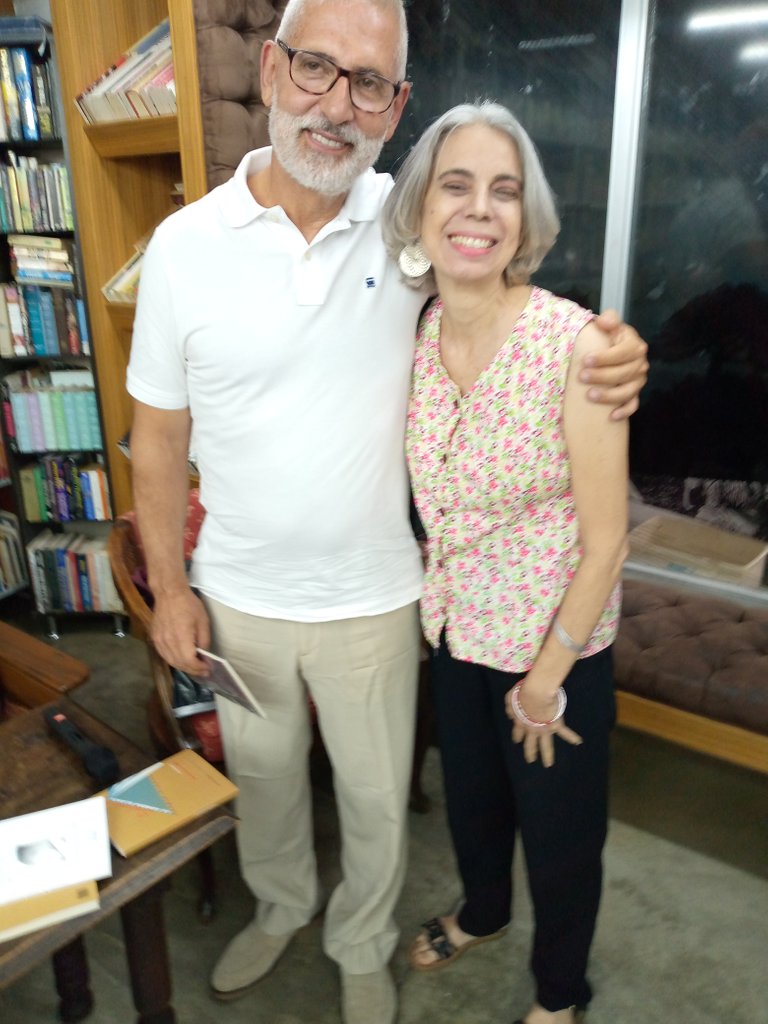
Fotos junto al poeta Fermín Higuera

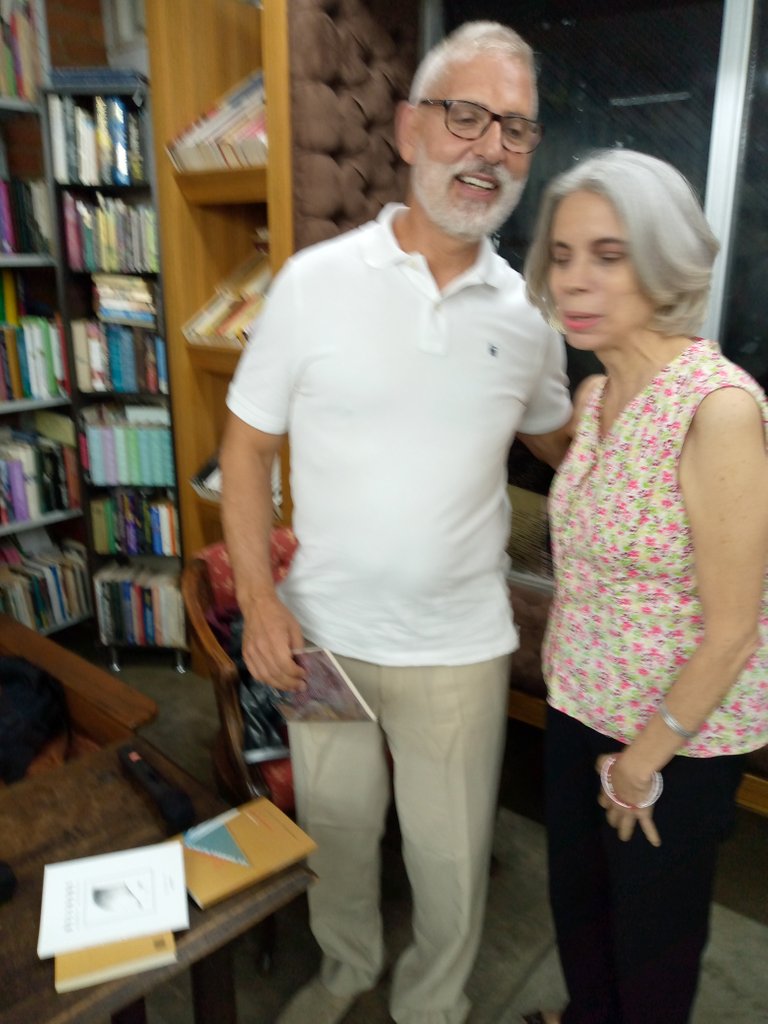
Fermín Higuera, poeta y pianista canario, estuvo un mes en Venezuela invitado por su prima Marisol Marrero Higuera, escritora de origen canario, quien tiene muchos años residenciada en nuestro país y es docente jubilada de la Universidad Central de Venezuela. El Círculo de Escritores de Venezuela aprovechó su visita familiar para organizar un recital poético de Higuera en la librería Kalathos, ubicada en el centro cultural Galpones de los Chorros en Caracas.
La música y la poesía
La música y la poesía están estrechamente vinculadas, los primeros poetas, en la antigüedad, se acompañaban con instrumentos musicales y cantaban sus poemas en fechas de celebraciones y en homenaje a los dioses. Entonces y durante muchos siglos la poesía tuvo rima, sonidos que se repetían y facilitaban recordar el poema. El ritmo, el sonido, es fundamental en la poesía. Genera en el lector determinada resonancia y esa conexión que se establece, a través del ritmo del texto y el lector o escucha, produce una emoción, mueve en él/ella sentimientos y recuerdos profundamente guardados en su memoria, que lo hacen vibrar en una determinada sintonía.
Sonido y energía despiertan en el escritor y el lector de poesía una honda emoción que no experimenta de manera habitual, porque a esa vibración que produce la musicalidad del texto, está unida la palabra y la imagen poética, que despiertan un imaginario y una emoción. En la poesía el tema, los motivos que se despliegan en el poema, están estrechamente vinculados con su ritmo, la potencialidad sonora en que el tema se muestra.
Si las notas y seminotas producen una vibración al escuchar una interpretación musical, en la escritura poética son las sílabas tónicas de las palabras las que generan una determinada vibración al escuchar el texto cuando lo leemos. Antiguamente, la rima al final del verso le daba una determinada tonalidad, un determinado ritmo al poema. Pero hoy en día la mayoría de los poetas no escribimos rimado y a veces inclusive escribimos en prosa.
El silencio
Tanto para la música como para la poesía el silencio es fundamental. La pausa, los momentos de silencio determinan el ritmo de la pieza musical o del poema. En el poema hay un pico de sonido al final del verso, un silencio o pausa y luego al iniciarse el verso siguiente se reanuda el sonido. En la preceptiva poética lo conocemos como “metro”, por lo menos en español. El metro del poema es el número de sílabas que posee un verso. A veces, no siempre, en algunos poemas se produce el encabalgamiento entre dos versos o más, el ritmo entre esos versos se une en sincronía. Hay poetas como Federico García Lorca que al leerlos sentimos encabalgamientos en todos los versos de algunos de sus poemas, en ellos la lengua, el español, canta. Es el caso de sus poemas del “Romancero Gitano”, pero también de algunos de sus sonetos, en cambio, en su libro “Poeta en New York” no hay esa musicalidad, su ritmo es más interior, al no presentar rima.
"RELIGARE"
En el libro que nos leyó el poeta y pianista canario Fermín Higuera “Religare”, publicado en Madrid por la editorial Polibea en 2011, se conjugan sus dos pasiones creativas, la música, a la cual se ha dedicado profesionalmente como intérprete y profesor y la poesía, que también le ha servido como vía de expresión a través del tiempo. El libro está conformado por tres partes: “Del arte de tocar el piano”, “Esbozos para un concierto de piano solo” y “Religare”.
Quisiera detenerme brevemente en el título del libro, que también da título a su última parte. Religare significa volver a unir, “volver a atar o ceñir más estrechamente una cosa”, así lo expresa en el prólogo Miguel Losada. Es la base de las religiones, y por lo tanto de la fe. En los grandes místicos esa fe va unida al éxtasis, la unión profunda del alma con Dios.
“Del arte de tocar el piano”
En la primera parte del libro el poeta canario recorre, a través de las palabras, lo que en realidad, es tacto y sonido, la experiencia del pianista cuando se entrega a su instrumento, cuando lo toca y es tocado por él, la vivencia del intérprete para quien todo abismo es vencido en esa entrega que le da arraigo, raíz, lo religa con la vida, así lo expresa bellamente en el tercer poema de la primera parte. El tacto, el tocar el instrumento se transforma en “estremecimiento”, en un diálogo, un habla con “las raíces de las cosas”, que es un diálogo “enardecido”, “que se sueña en el ahora”:
“Podrás yacer en el abismo
o volar sin fundamento
en las alturas huecas
pero tocas el piano
y al hacerlo sonar
le hablas a las raíces de las cosas
No te olvides de que no eres nada
sino tacto enardecido
tránsito en conciencia de sí
por el estremecimiento del roce
por el enardecimiento del diálogo
que se sueña en el ahora
No olvides que sólo eres real
cuando tocas y te tocan”
El piano “es un faro que atrae hacia la luz/lo (sic) seres extraviados” expresa en el poema IV, pero además es un vínculo con lo materno y lo femenino, esto reitera la imagen de protección, porque es la madre su primera maestra de piano, “fue mi madre quien me dio el piano”, señala en el poema V. Así también, el aprendizaje durante muchos años para ser intérprete del piano es una vía de conocimiento de sí mismo, “larga la vigilia de aprender a conocernos”, “lo que importa es la llegada/la confirmación de la certeza”, poema VI. Pero al mismo tiempo reitera “Sabemos que nuestro saber no es nuestro/y también que nuestro canto no es nuestro”. Al final toda esa búsqueda, toda esa entrega cobra sentido, conlleva una suerte de búsqueda espiritual, un vínculo con lo trascendente, con lo “impalpable”, con “los ausentes” :
“Todo sea para oír lo inaudible
para tocar lo impalpable
encarnar la confluencia de los ausentes
en el arco del abrazo
en un solo instante
ser cruz del sentir que fluye y nos borra”
En el último texto que conforma la primera parte, el X, escrito en prosa poética, se anticipa la segunda parte, escrita toda en prosa poética, la cual dedica a diversos compositores de música académica.
“Esbozos para un concierto de piano solo”
Al igual que los grandes poetas encuentran su voz, su temperamento, los reconocemos y distinguimos por ciertos ritmos, palabras y obsesiones que se reiteran en su poética, igualmente el pianista tiene un temperamento que va encontrando, compositores por los que siente predilección. Chopin, por ejemplo, era uno de los compositores predilectos de mi abuela, Adelina Villasmil Fuentes, la madre de mi padre, que sin llegar a ser concertista, tocaba piano y encontró sustento dando clases de piano, al separarse de mi abuelo Luis Martín. No la conocí, cuando nací ella ya había muerto, pero debió tener un alma de temperamento romántico.
En la segunda parte de su libro “Religare”, el poeta y pianista Higuera, nos ofrece en prosa poética su vínculo como intérprete con la obra de varios compositores, lo hermoso y sorprendente de estos textos es como de esos acordes musicales van surgiendo bellas imágenes poéticas. No se trata de composiciones musicales temáticas, como por ejemplo, “El sueño de un fauno” de Debussy. Evidentemente, son compositores y obras, que de una manera sinestésica, además de producir determinadas vibraciones sonoras, generan en el poeta un imaginario poético extraordinario, imágenes metafóricas de gran lirismo. Les comparto el texto que dedica al “Preludio No. 5 Op 28 de Chopin”:
“Y si la dificultad no fuese tanta, sino un juego, el eco de un sí que antes tensaba la melancolía y ahora aflora como los estambres en medio de la flor de las extensiones, salpicando el arpegio que ya no es una cabriola, sino un recorrido de acendramiento para el volantinero sonriente.
Y si esta oposición para los dedos, que parece insalvable tan solo fuese la algarabía de los petirrojos en las manos.”
“Religare"
Buscar la epifanía, el estado de gracia en el canto, tentando las vibraciones de la música con los pájaros del poema. Uniendo la oscuridad profunda, “el infierno”, con “el destello de las alas”. Las irradiaciones de la imagen poética suscitan esas confluencias imposibles, la búsqueda “de un nuevo edén”, nos dice el poeta en la última parte de su libro. Pero en esa búsqueda importa el otro, se busca un diálogo, la configuración de “un lugar de acogida/ donde se muestre y se pronuncie/el abrazo desconocido”. Se plantea el poema como lugar de acogida para que sea un lugar de sanación:
“El verdadero credo
es sanarte a ti mismo
y sanar a los otros”
Detrás de ese largo camino, de esa búsqueda que ha tenido como instrumento el piano, y la poesía, detrás de esa búsqueda trascendente que une tacto, la piel del mundo en las teclas del piano, como punto de llegada está el amor al prójimo, es en el diálogo y en la sanación propia y de los otros que esa búsqueda cobra sentido. El “religare” no se da en la soledad, se da en la ofrenda al otro, al prójimo, como Fermín Higuera ya expresaba en la primera parte del libro “No olvides que sólo eres real/cuando tocas y te tocan”. Muchas gracias al poeta Fermín Higuera por compartir con nosotros sus versos y particularmente por habérmelos obsequiado.
Contenido original, escrito para Hive. Todas las imágenes, salvo que se exprese otra fuente, fueron tomadas con la cámara de mi teléfono móvil Infinix HOT 10. Gracias por tu lectura.
 English version
English version
We are energy, the universe is energy and everything alive in it is energy. On this interesting subject I heard two poets and pianists, Edgar Vidaurre, current president of the Circle of Writers of Venezuela and Fermín Higuera (Santa Cruz de Tenerife, 1961), talk at the Kalathos bookstore in Caracas, this Friday, June 23, 2023. They met that afternoon, but a wonderful synchronicity was established between them that I had the privilege of witnessing. They talked about music and musical interpretation, but ended up talking about music and quantum energy. Poet Carmen Cristina Wolf and actress and poet Yoyiana Ahumada also accompanied the Canarian poet at the event.
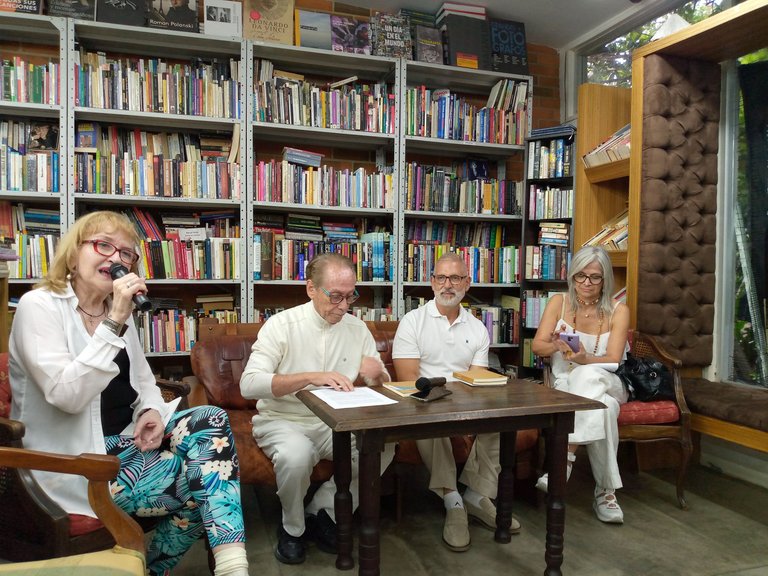
Photos taken with my Infinix HOT 10 cell phone camera.
The poet Carmen Cristina Wolf welcoming the event.
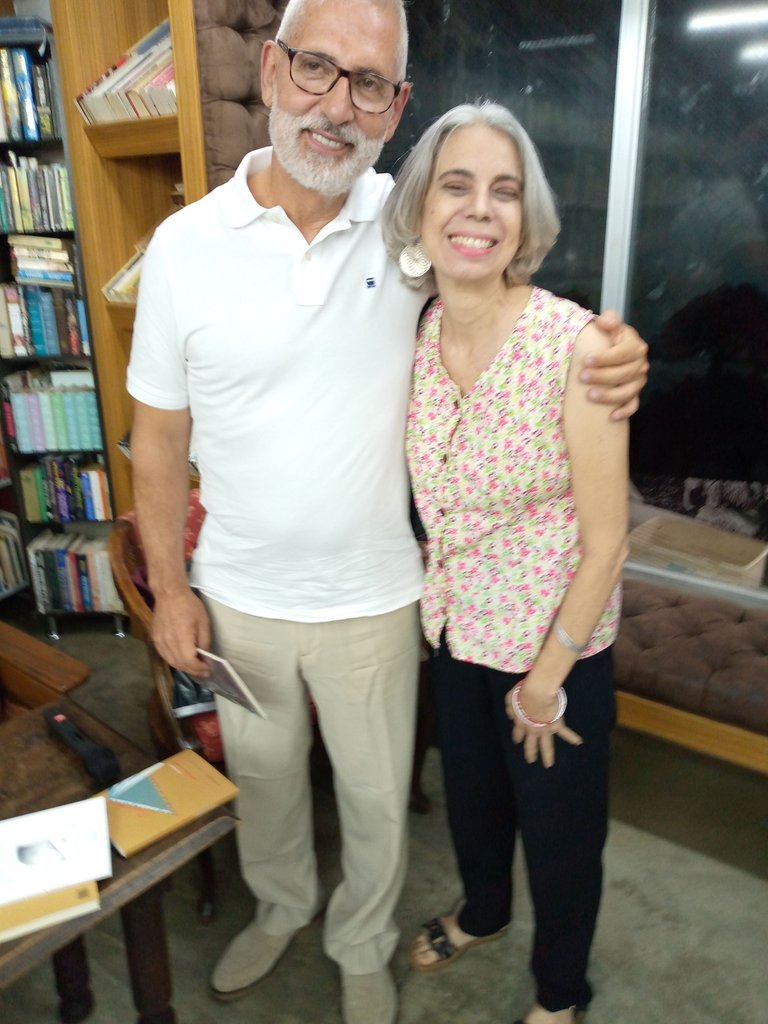
Photos with the poet Fermín Higuera
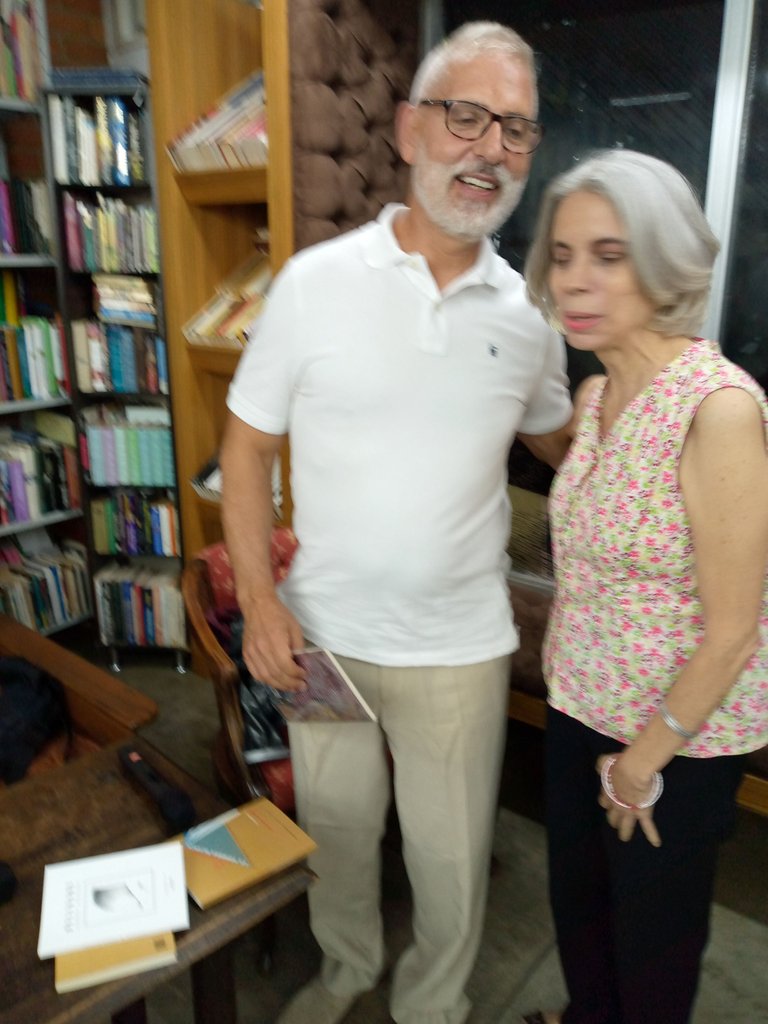
Fermín Higuera, poet and pianist from the Canary Islands, spent a month in Venezuela at the invitation of his cousin Marisol Marrero Higuera, a writer of Canarian origin, who has lived in our country for many years and is a retired professor at the Central University of Venezuela. The Venezuelan Writers Circle took advantage of his family visit to organize a poetry recital by Higuera at the Kalathos bookstore, located in the Galpones de los Chorros cultural center at Caracas.
Music and poetry
Music and poetry are closely linked, the first poets, in ancient times, accompanied themselves with musical instruments and sang their poems on dates of celebrations and in homage to the gods. Then and for many centuries poetry had rhyme, sounds that were repeated and made it easier to remember the poem. Rhythm, sound, is fundamental in poetry. It generates in the reader a certain resonance and that connection that is established, through the rhythm of the text and the reader or listener, produces an emotion, moves in him/her feelings and memories deeply stored in his/her memory, which make him/her vibrate in a certain tune.
Sound and energy awaken in the writer and the reader of poetry a deep emotion that he/she does not usually experience, because to that vibration produced by the musicality of the text, the word and the poetic image are united, which awaken an imaginary and an emotion. In poetry, the theme, the motifs that unfold in the poem, are closely linked to its rhythm, the sonorous potentiality in which the theme is shown.
If the notes and semi-notes produce a vibration when we listen to a musical interpretation, in poetic writing it is the tonic syllables of the words that generate a certain vibration when we listen to the text as we read it. Formerly, the rhyme at the end of the verse gave a certain tonality, a certain rhythm to the poem. But nowadays most of us poets do not write in rhyme and sometimes we even write in prose.
The silence
For both music and poetry, silence is fundamental. The pause, the moments of silence determine the rhythm of the piece of music or the poem. In the poem there is a peak of sound at the end of the verse, a silence or pause and then at the beginning of the next verse the sound resumes. In poetic precepts we know it as "meter", at least in Spanish. The meter of the poem is the number of syllables in a line of poetry. Sometimes, but not always, in some poems there is an enjambment between two or more lines, the rhythm between those lines is united in synchrony. There are poets like Federico García Lorca that when we read them we feel enjambment in all the lines of some of his poems, in them the language, the Spanish language, sings. This is the case of his poems of the "Romancero Gitano", but also of some of his sonnets, on the other hand, in his book "Poeta en New York" there is no such musicality, its rhythm is more interior, as it does not present rhyme.
"RELIGARE"
In the book read to us by the Canarian poet and pianist Fermín Higuera "Religare", published in Madrid by Polibea in 2011, his two creative passions come together: music, to which he has dedicated himself professionally as a performer and teacher, and poetry, which has also served him as a means of expression over time. The book is made up of three parts: "On the Art of Playing the Piano", "Sketches for a Solo Piano Concerto" and "Religare".
I would like to dwell briefly on the title of the book, which also gives title to its last part. Religare means to re-unite, "to bind or gird a thing more tightly", as Miguel Losada puts it in the prologue. It is the basis of religions, and therefore of faith. In the great mystics, this faith is linked to ecstasy, the profound union of the soul with God.
"Of the art of playing the piano".
In the first part of the book the poet from the Canary Islands goes through, through words, what in reality, is touch and sound, the experience of the pianist when he surrenders to his instrument, when he plays it and is played by it, the experience of the interpreter for whom every abyss is overcome in that surrender that gives him roots, roots, religions him with life, so he expresses it beautifully in the third poem of the first part. The touch, the touching of the instrument is transformed into "trembling", into a dialogue, a speech with "the roots of things", which is a "fiery" dialogue, "which is dreamed in the now":
"You may lie in the abyss
or fly without foundation
in the hollow heights
but you play the piano
and when you play it
you speak to the roots of things
Don't forget that you are nothing
but a burning touch
transit in self-consciousness
by the shudder of touch
by the flaming of the dialogue
that is dreamed in the now
Don't forget that you are only real
when you touch and are touched".
The piano "is a lighthouse that attracts to the light/lo (sic) lost beings" he expresses in poem IV, but it is also a link with the maternal and the feminine, this reiterates the image of protection, because his mother is his first piano teacher, "it was my mother who gave me the piano", he points out in poem V. Likewise, learning for many years to be a piano player is a way of self-knowledge, "long the vigil of learning to know ourselves", "what matters is the arrival/confirmation of certainty", poem VI. But at the same time he reiterates "We know that our knowledge is not ours/and also that our song is not ours". In the end all that search, all that surrender makes sense, it entails a sort of spiritual quest, a link with the transcendent, with the "impalpable", with "the absent" :
"Everything is to hear the inaudible
to touch the impalpable
to incarnate the confluence of the absentees
in the arc of the embrace
in a single instant
to be the cross of the feeling that flows and erases us".
In the last text that makes up the first part, X, written in poetic prose, the second part is anticipated, written entirely in poetic prose, which is dedicated to various composers of academic music.
"Sketches for a solo piano concerto."
Just as the great poets find their voice, their temperament, we recognize and distinguish them by certain rhythms, words and obsessions that are reiterated in their poetry, so the pianist has a temperament that he finds, composers for whom he feels a predilection. Chopin, for example, was one of the favorite composers of my grandmother, Adelina Villasmil Fuentes, my father's mother, who, without becoming a concert pianist, played piano and found a livelihood giving piano lessons, when she separated from my grandfather. I never met her, when I was born she had already died, but she must have had a soul with a romantic temperament.
In the second part of his book "Religare", the poet and pianist Higuera, offers us in poetic prose his link as a performer with the work of several composers, the beautiful and surprising thing about these texts is how beautiful poetic images emerge from these musical chords. These are not thematic musical compositions, like, for example, Debussy's "The Dream of a Faun". Evidently, they are composers and works, which in a synaesthetic way, besides producing certain sound vibrations, generate in the poet an extraordinary poetic imaginary, metaphorical images of great lyricism. I share with you the text he dedicates to Chopin's "Prelude No. 5 Op 28":
"And if the difficulty were not so much a game, but a game, the echo of a yes that once strained melancholy and now emerges like the stamens in the middle of the flower of the extensions, splashing the arpeggio that is no longer a caper, but a path of accentuation for the smiling fledgling.
And if this opposition for the fingers, which seems insurmountable, were only the chatter of the robins in the hands."
“Religare”
Seeking the epiphany, the state of grace in song, tempting the vibrations of music with the birds of the poem. Joining the deep darkness, "hell", with "the flash of wings". The irradiations of the poetic image give rise to these impossible confluences, the search "for a new Eden," the poet tells us in the last part of his book. But in this search the other is important, a dialogue is sought, the configuration of "a place of welcome/ where the unknown embrace is shown and pronounced". The poem is posited as a place of welcome to be a place of healing:
"The true credo
is to heal yourself
and heal others".
Behind this long road, behind this search that has had the piano as an instrument, and poetry, behind this transcendent search that unites touch, the skin of the world in the keys of the piano, as a point of arrival is the love of others, it is in the dialogue and in the healing of oneself and others that this search makes sense. The "religare" does not happen in solitude, it happens in the offering to the other, to the neighbor, as Fermín Higuera already expressed in the first part of the book "Do not forget that you are only real/when you play and you are touched". Many thanks to the poet Fermín Higuera for sharing his verses with us and particularly for having given them to me as a gift.
Original content, written for Hive. All images, unless another source is expressed, were taken with my Infinix HOT 10 cell phone camera. Thank you for reading.


 Fotos tomadas con la camera de mi teléfono móvil Infinix HOT 10
Fotos tomadas con la camera de mi teléfono móvil Infinix HOT 10








Esta publicación ha recibido el voto de Literatos, la comunidad de literatura en español en Hive y ha sido compartido en el blog de nuestra cuenta.
¿Quieres contribuir a engrandecer este proyecto? ¡Haz clic aquí y entérate cómo!
Muchas gracias por el apoyo @es-literatos
Gracias por compartirnos tus reflexiones acerca de esa alada relación entre música y poesía, y, a la vez, darnos a conocer una expresión particular de tal relación en el poemario de Fermín Higuera, con hermosos poemas en verso y en prosa. Saludos, @beaescribe.
Muchas gracias, profesor. Me honra su lectura y comentario. El recital del poeta Fermín Higuera en Caracas fue algo excepcional y me llevó a todas esas reflexiones.
¡Felicidades! Esta publicación obtuvo upvote y fue compartido por @la-colmena, un proyecto de Curación Manual para la comunidad hispana de Hive que cuenta con el respaldo de @curie.
Si te gusta el trabajo que hacemos, te invitamos a darle tu voto a este comentario y a votar como testigo por La Colmena.
Si quieres saber más sobre nuestro proyecto, te invitamos a acompañarnos en nuestro servidor de Discord.
Muchas gracias por el apoyo amigos de @la-colmena
Que privilegio sin duda alguna estar presente entre música y letras, quedarías atrapada allí entre sonidos vocales. Muchísimo éxito @beaescribe un abrazo.
What a privilege without a doubt to be present between music and lyrics, you would be trapped there between vocal sounds. Much success @beaescribe a hug.
Gracias, querida @sacra97 Un abrazo trasatlántico. 🤗
Has sido curado por @visualblock / You've been curated by @visualblock
Bienvenidas delegaciones / Delegations welcome
Encuentra nuestra comunidad aquí / Find our community here
Trail de Curación / Curation Trail
Vota por nuestro Testigo aliado - @hispapro / Vote for our allied Witness - @hispapro
Más información sobre el testigo aquí / More information about the witness here
Estimados amigos, ya voté por hispapro como testigo, la semana pasada. Me contenta el fortalecimiento de la comunidad hispana en Hive. 😀
¡Muchas gracias por tu apoyo al testigo! Este es nuestro nuevo banner de curación, seguirás viéndolo de momento. 😁🤗
¡Qué linda tarde de música y poesía debes haber pasado mi querida amiga! Me gustó tu post y la experiencia, además de haber compartido ese día, con inminentes escritores de poesía. Cariños @beaescribe.🤗😍
Así fue querida @numa26 Una bella tarde de poesía. 🤗😘
My previous @v4vapp proposal has expired. I have a new one which is running but unfunded right now. I'm still running @v4vapp and all my other services.
I've just updated v4v.app and I'm getting ready for some exciting new features after the next hard fork.
Please consider asking your friends to vote for prop #265 or consider unvoting the return vote.
For understandable reasons in the current crypto climate it is harder to get funded by the DHF, I accept this so I'm asking a wider audience for help again. I'll also add that I power up Hive every day and usually power up larger amounts on 1st of the Month. I'm on Hive for ideological reasons much more than for only economic benefit.
Additionally you can also help with a vote for Brianoflondon's Witness using KeyChain or HiveSigner
If you have used v4v.app I'd really like to hear your feedback, and if you haven't I'd be happy to hear why or whether there are other things you want it to do.